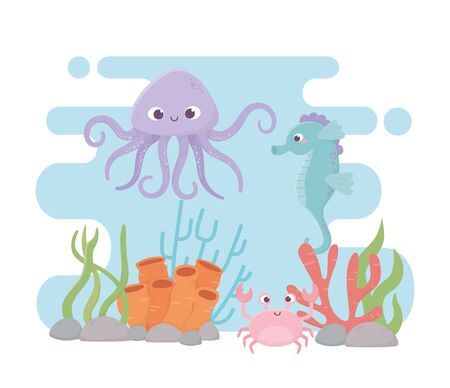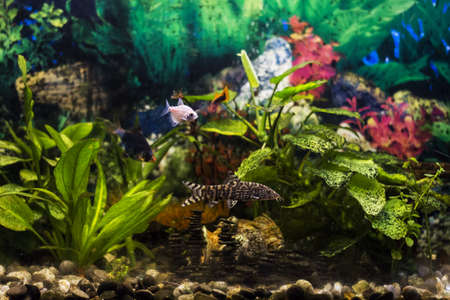1. Introduction to Aquatic Plant and Coral Selection in the UK
When it comes to curating a thriving aquatic environment, whether you’re passionate about freshwater tanks filled with lush greenery or mesmerising marine aquariums teeming with vibrant corals, your choices are shaped by more than just personal taste. In the UK, aquatic hobbyists face a unique set of considerations that influence which plants and corals truly flourish. The British climate, with its cooler temperatures and variable sunlight, plays a significant role in determining suitable species for indoor aquaria. Equally important is the local water quality—UK tap water tends to be hard and alkaline in many regions, impacting both plant growth and coral health. Moreover, trends within the UK aquarium community increasingly lean towards sustainable practices, favouring hardy native or easily acclimatised species that require less intervention and reduce ecological impact. This introduction sets the stage for understanding how climate, water chemistry, and modern hobbyist preferences converge to define the best choices for both freshwater and marine setups across Britain.
Top Aquatic Plants for UK Freshwater Aquariums
If you’re setting up a freshwater tank in the UK, choosing the right plants is essential for creating a thriving aquatic ecosystem. The British climate and water conditions favour certain hardy and vibrant species—some of which are even native to local waterways. Whether you’re a fan of lush aquascapes or prefer low-maintenance greenery, there’s something for every aquarist. Below, you’ll find a handy guide to some of the best options, including their availability in UK aquatic shops and suitability for various aquarium setups.
Native and Hardy Choices
Opting for plants that naturally flourish in Britain means less fuss with acclimatisation and generally stronger growth. Some popular native and well-adapted choices include:
| Plant Name | Origin | Tank Type Suitability | Ease of Care | Availability in the UK |
|---|---|---|---|---|
| Elodea canadensis (Canadian Pondweed) | Naturalised in the UK | Beginner to Advanced | Very Easy | Widely available |
| Ceratophyllum demersum (Hornwort) | Native/Local waters | Coldwater & Tropical | Easy | Common in shops |
| Lemna minor (Duckweed) | Native UK species | All setups (surface plant) | Very Easy | Readily available |
| Cryptocoryne wendtii | Southeast Asia; widely kept in UK tanks | Tropical setups | Moderate | Easily sourced |
| Anubias barteri var. nana | Africa; robust in British tanks | Tropical & Low-tech tanks | Easy | Popular choice, always in stock |
| Vallisneria spiralis (Straight Vallis) | Eurasian; adapted locally | Larger/community tanks | Easy-Moderate | Commonly found in stores |
The Practical Side: Matching Plants to Setups and Fish Species
Your choice of aquatic plants should also reflect your tank’s residents and setup style. For example, Elodea and Hornwort are excellent for goldfish tanks, providing both oxygenation and natural cover. Cryptocoryne wendtii suits planted aquascapes where stable water parameters can be maintained, while Anubias is perfect for those who prefer attaching greenery to rocks or driftwood—ideal for shrimp or betta tanks. Always check with your local aquatic shop for current stock and advice tailored to your specific water conditions.
Aquatic Plant Shopping Tips in the UK:
– Support independent aquarium shops where staff often know their stuff
– Ask about sourcing—UK-grown plants tend to adapt better than imported ones
– Look out for snail-free or tissue-cultured options if you want to avoid hitchhikers
– Consider seasonal variations; some plants are more readily available spring through autumn
– Dont forget: mixing native and tropical species can create visually interesting but ecologically balanced tanks suitable for Britain’s unique tap water profile!

3. Popular Live Corals for Marine Aquariums in the UK
When it comes to setting up a thriving marine aquarium in the UK, live corals add both beauty and biodiversity to your underwater world. However, choosing the right corals can be a challenge, especially with the UKs strict import regulations and ever-changing local availability. Here’s a rundown of some of the most popular and beginner-friendly corals suited for British marine aquarists, plus tips on sourcing them responsibly.
Sought-After Soft Corals
Soft corals are an excellent starting point for those new to marine tanks. Varieties like Zoanthids, Mushroom Corals (Discosoma), and Kenya Tree Coral (Capnella) are prized among UK hobbyists for their hardiness and vibrant colours. They’re generally tolerant of slight fluctuations in water parameters, which makes them ideal for less experienced keepers or smaller nano setups. Many reputable aquatic shops across Britain stock tank-raised specimens that have adapted well to captive life.
LPS Corals: Colourful Yet Manageable
Large Polyp Stony (LPS) corals such as Hammer Coral (Euphyllia ancora), Torch Coral (Euphyllia glabrescens), and Candy Cane Coral (Caulastrea) are favourites due to their dramatic appearance and relative ease of care. These species are widely available from UK-based marine specialists, many of whom prioritise sustainably farmed options to avoid wild collection pressures. Always check that your supplier is reputable and complies with CITES regulations, ensuring ethical sourcing practices.
SPS Corals: For the Dedicated Enthusiast
Small Polyp Stony (SPS) corals like Montipora and Acropora are highly sought after by advanced aquarists looking for a technical challenge and stunning visual payoff. While they require stable water chemistry and strong lighting, more UK retailers now offer aquacultured frags that are better suited to home aquaria than wild-caught alternatives. If you’re keen to try SPS, start with hardier varieties and consult local reefing communities or forums for advice on best practice in British conditions.
Local Sourcing & Import Considerations
Due to post-Brexit changes, importing corals into the UK has become more regulated—requiring import permits and proof of sustainable collection or farming. To avoid legal pitfalls and reduce environmental impact, always buy from established UK suppliers who can provide traceability for their livestock. Many independent aquatic stores collaborate with domestic coral farms, so you can support local businesses while stocking your tank with healthy, adaptable specimens. Lastly, joining regional reef clubs can be invaluable for swapping frags and sharing practical husbandry tips tailored to Britain’s unique aquarium scene.
4. Caring for Your Aquatic Plants and Live Corals
Looking after aquatic plants and live corals in your UK home aquarium requires more than just a keen eye—it’s about understanding the specific needs of each species and creating an environment where they can truly thrive. Whether you’re nurturing a lush, planted freshwater tank or a vibrant marine reef, here’s practical guidance tailored for British aquarists.
Optimal Lighting for Healthy Growth
Lighting is crucial for both freshwater plants and marine corals. Most UK hobbyists find that natural daylight isn’t sufficient, especially during our famously gloomy winters, so investing in quality LED or fluorescent aquarium lighting is essential. Here’s a quick reference:
| Type | Recommended Lighting | Photoperiod (Hours/Day) |
|---|---|---|
| Freshwater Plants | Full-spectrum LEDs (6,500–7,000K) | 8–10 |
| Marine Corals | Reef-specific LEDs (10,000–20,000K) | 8–12 |
Essential Water Parameters: UK Tap Water Considerations
The UK’s tap water varies from region to region—harder in places like London and softer in Scotland and the North. Regular testing and adjustments are vital. Here’s what to aim for:
| Parameter | Freshwater Plants Range | Marine Corals Range |
|---|---|---|
| Temperature | 22–26°C (72–79°F) | 24–27°C (75–81°F) |
| pH Level | 6.5–7.5 | 8.0–8.4 |
| Hardness (GH/KH) | Varies—aim for moderate (6-10 dGH) | N/A (focus on calcium/magnesium levels) |
| Nitrates/Nitrites/Ammonia | <20ppm Nitrate; 0 Nitrite/Ammonia | <5ppm Nitrate; 0 Nitrite/Ammonia |
| Salinity (marine only) | N/A | 1.023–1.025 SG |
| Calcium/Magnesium (marine only) | N/A | Ca: 400–450ppm; Mg: 1250–1350ppm |
Topping Up & Water Changes: A British Routine
Aquatic plants benefit from weekly 20% water changes using dechlorinated tap water, while marine tanks need RO or distilled water to avoid unwanted minerals found in hard tap water common across much of England.
Feeding Routines and Supplements
For Freshwater Plants: Dose liquid fertilisers containing iron, potassium, and micronutrients once or twice a week—brands readily available at most UK aquatics shops work well. For root feeders like Cryptocoryne, bury root tabs near their base every month.
For Marine Corals: Many soft corals thrive under good lighting alone, but LPS and SPS species often benefit from supplemental feeding with coral foods such as phytoplankton or amino acids two to three times per week.
A Final Word: Consistency Is Key
The secret to flourishing aquatic life in any British home? Regular testing, attentive observation, and sticking to routines—even when life gets busy or the weather outside is typically unpredictable! By tailoring your care to local water conditions and seasonal light availability, you’ll enjoy a thriving underwater world year-round.
5. Where to Buy: Trusted UK Aquatic Plant and Coral Suppliers
Finding healthy, ethically-sourced aquatic plants and live corals is paramount for the success of your freshwater or marine aquarium in the UK. Fortunately, there’s a wealth of reputable British retailers, online platforms, and even specialist societies that cater to aquarists seeking top-quality stock. Below is a curated list to help you source the best for your tank.
Specialist Aquatic Retailers
1. The Green Machine (North Wales): Known across the UK for premium aquatic plants, aquascaping supplies, and expert advice, The Green Machine offers both in-store and online shopping options.
2. Pro Shrimp (Nottingham): With a wide range of freshwater plants, shrimp-friendly botanicals, and accessories, Pro Shrimp is favoured by many hobbyists for their healthy stock and prompt delivery.
3. Charterhouse Aquatics (London & Online): A one-stop shop for both freshwater and marine enthusiasts, Charterhouse boasts an impressive selection of aquatic plants as well as sustainably sourced corals.
Online Platforms for Nationwide Delivery
1. Aquarium Gardens: Based in Cambridgeshire but delivering throughout the UK, Aquarium Gardens specialises in lush aquatic plants suitable for both beginners and seasoned aquascapers.
2. Real Reefs: Focusing on maricultured and tank-grown corals, Real Reefs provides responsibly sourced marine life with UK-wide shipping and clear sustainability credentials.
Aquarium Societies & Local Clubs
Don’t overlook the value of joining local aquarium societies such as The British Aquatic Plant Society (BAPS) or regional branches of the Marine Conservation Society. These groups frequently host plant swaps, coral frag events, and offer guidance on sourcing trusted suppliers near you.
A Few Tips Before You Buy
- Always check that suppliers have strong reviews from UK hobbyists.
- Enquire about quarantine practices for new arrivals—this helps avoid introducing pests or diseases to your tank.
- If possible, visit physical shops to inspect plant health or coral polyp extension before purchasing.
Sourcing from reputable suppliers not only ensures the health of your aquatic life but also supports sustainable practices within the UK aquarium community. Whether you’re looking to build a lush planted tank or a thriving reef system, these trusted sources will help bring your aquascaping dreams to life.
6. Personal Experience: Setting Up My British Aquascape and Reef Tank
As a passionate aquarist living in the UK, setting up both a lush freshwater aquascape and a vibrant marine reef tank has been an unforgettable journey—one filled with both unexpected challenges and satisfying victories. I’d like to share my hands-on experience to help fellow hobbyists navigate their own aquatic adventures on British soil.
Getting Started: The Joys and Jitters of Sourcing
My first hurdle was sourcing healthy aquatic plants and live corals. While large chains like Maidenhead Aquatics offer a decent selection, I found that local independent shops and reputable online UK retailers provided unique species and better advice tailored to our water conditions. For my freshwater tank, I opted for hardy staples like Vallisneria and Anubias, while my reef tank started with beginner-friendly soft corals such as Zoanthids from trusted British suppliers.
Taming Tap Water: The Great British Balancing Act
The next big challenge was dealing with our famously hard tap water. For the planted tank, I invested in a RO (reverse osmosis) unit to soften the water, which made delicate plants thrive and kept algae at bay. The marine setup required careful mixing of saltwater using RO water as well, plus regular testing for calcium, alkalinity, and magnesium—a must for coral health.
Climate Considerations: Battling the British Weather
The UK’s fluctuating temperatures meant that reliable heaters were essential in winter, while summer heatwaves called for fans or chillers—especially crucial for sensitive corals like Euphyllia. I learned quickly that stability is key; even minor temperature swings could stress both plants and corals, so investing in quality kit was non-negotiable.
Triumphs: Watching Life Flourish
Despite these hurdles, seeing my Cryptocoryne carpets spread and my torch corals extend their tentacles was worth every effort. Local aquascaping groups on social media were a goldmine for advice specific to British conditions, from coping with lime scale to dealing with postal delays during coral shipping. Over time, my tanks became miniature British biotopes—lush underwater gardens and bustling reefs full of colour and life.
Final Thoughts: Advice for Fellow UK Hobbyists
If you’re starting your own aquascape or reef tank in the UK, embrace the learning curve and don’t be afraid to ask local experts for advice. Invest in good water treatment gear, research plant and coral compatibility with your tap water, and join community forums to share tips about sourcing, weather woes, and maintenance routines. With patience and a bit of British resourcefulness, your aquatic world will soon thrive just as mine has.


